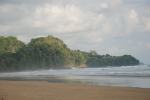Tourism is Costa Rica’s top industry and new research shows North Americans traveling there in 2008 to fish generated $599 million – or about two percent of Costa Rica’s gross domestic product.
The study, conducted in 2009 by The Billfish Foundation, Southwick Associates and the Universidad de Costa Rica (UCR), revealed 283,790 anglers visited Costa Rica and their economic impact even overshadowed commercial fishing. It was estimated 22 percent of those tourists visited the country for the exclusive purpose of fishing.
From that $599 million the study also showed sportfishing generated almost $78 million in tax revenues for Costa Rica and 63,000 jobs. In comparison, the effect of commercial fishing for the same species sought by anglers generated approximately $528 million to Costa Rica’s gross domestic product. Commercial fishing contributed $68.6 million in tax revenue and created 57,000 jobs.
“We have already had the opportunity to present the results of this study to the incoming vice president and minister of tourism,” said Ellen Peel, president of The Billfish Foundation. “And we will be making a formal presentation to a wider cross sector of government and business leaders this summer. The leadership in Costa Rica had no idea that their country receives more benefits from a sustainable recreational harvest than from the subsidized excessive effort in the commercial fishery.”
The comprehensive study included interviewing tourists at Costa Rica’s major airports to estimate the percentage who fished while visiting. The research focused on the expenditures and economic impacts of marlin, sailfish, yellowfin tuna, wahoo and dorado; species that are the most frequent targets of commercial fisherman and recreational anglers.
It was estimated the 283,790 North Americans visiting Costa Rica in 2008 spent a total of $467 million. The survey revealed $329 million was spent on travel including lodging ($119 million), restaurants ($15.6 million), flights and fishing guides ($88 million) and land transportation ($6 million). These dollars then change hands multiple times in Costa Rica, creating significant benefits for the nation’s gross domestic product. In addition, visitors spent approximately $105 million outside of Costa Rica prior to arrival for airfare or other travel expenses, though these dollars are not included in the economic analyses.
About 3,700 of those visiting Costa Rica have their own boats in the country, whether permanently or temporarily, and they spent approximately $138 million for items such as fuel ($45.6 million), maintenance and repairs ($25 million), furniture and accessories for their vessels ($48 million), staff and crews ($2.8 million), marina fees ($16.6 million), and taxes and insurance ($1.8 million).
“TBF believes that only when decision makers understand the economic importance of good fishing opportunities for tourist anglers will billfish conservation get on the radar screen of government leaders charged with economic development as well as fisheries management,“ said Dr. Russell Nelson chief scientist for TBF. “And now thanks to the dedication of TBF members and generous donors who have supported our socio-economic research, we are making the point.”
Additional work conducted in the U.S. by Southwick Associates, Inc. estimated 7.5 million Americans fished outside of their country in 2009 with 3.6 percent of them traveling to Costa Rica. Among anglers vacationing in Costa Rica, 40 percent said they would not have visited the country if they could not fish. Those anglers, who represent 116,000 visitors per year and about $135 million in tourism income for Costa Rica, said the main factor in determining their satisfaction is “quality of fishing” followed by “relative peace and quiet,” and “fishing services, boat and crew quality.” The majority of anglers reported they visited Costa Rica to catch billfish including sailfish, marlin along with dorado. Inshore species such as snook and tarpon were less frequent targets.
“This was the first study done in Central America that compares the economic contributions of recreational and commercial fishing for the same species,” said Rob Southwick, president of Southwick Associates, who coordinated design and methodology, management and monitoring of this research and generated information regarding U.S. anglers’ international travel activities. “We’ve completed similar work for Los Cabos, Mexico, and the results produced almost immediate benefits to fisheries management and conservation.”
That study found the Los Cabos area benefited by $1.1 billion to the economy.
Based on the success of socio-economic research in Mexico and Costa Rica, TBF already has entered into discussions with the new administration in Panama to conduct similar studies in that country.
There is great offshore fishing 20 minutes away from The Village of San Buenas. Let us know when you are visiting and we can line up a trip for you!
Complete reports are available at: www.billfish.org



